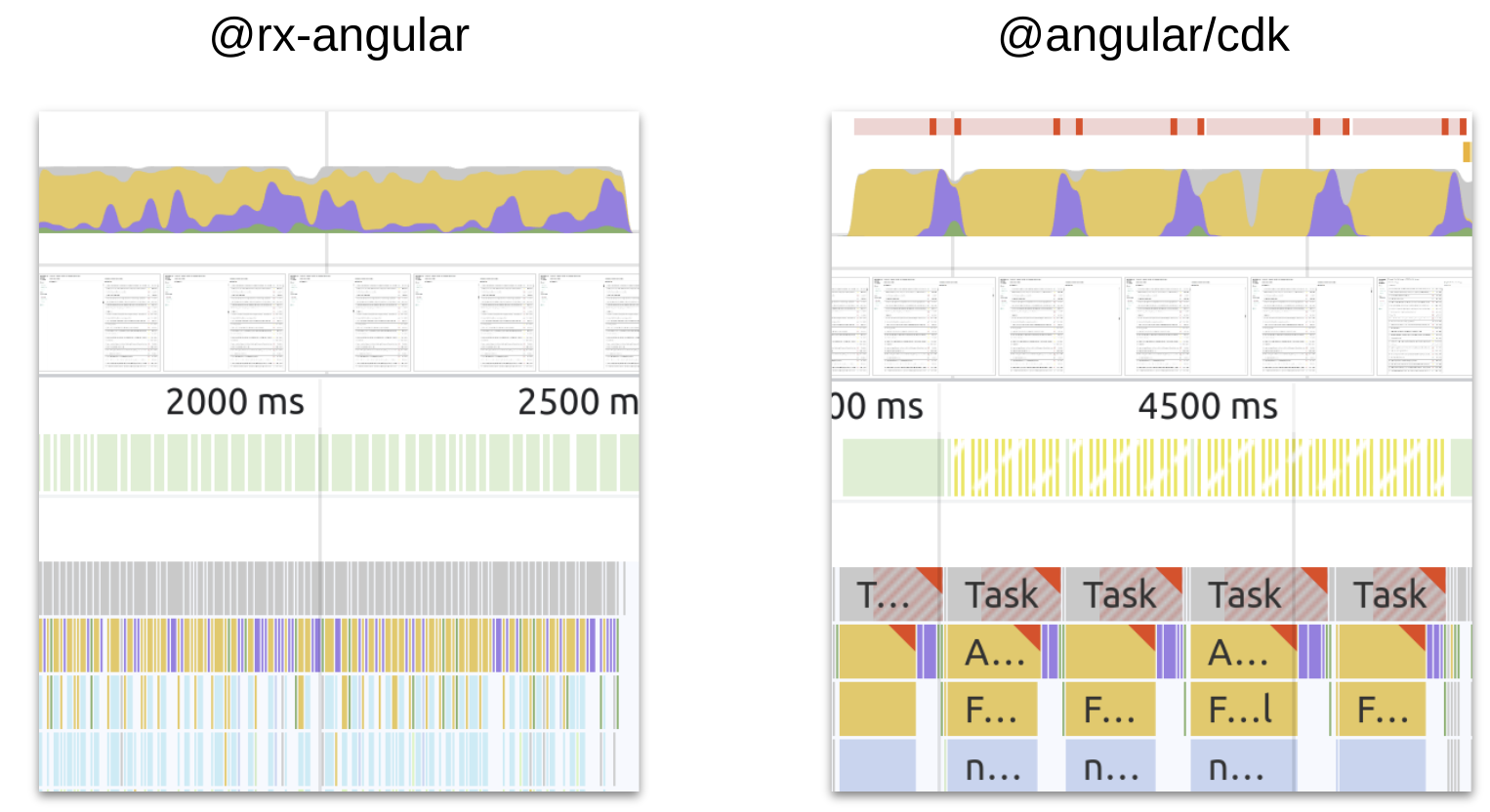This is a playground/development repository. It served to test out ideas and concepts. It also hosts a demo application
The code you see here is the latest version of the currently existing PR on rxa, just copied over to serve the demo with the latest version.
A high performance alternative to @angular/cdk/scrolling virtual scrolling implementation.
Instead of rendering every item provided, rxVirtualFor only renders what is currently visible to the user, thus providing
excellent runtime performance for huge sets of data.
The technique to render items is comparable to the one used by twitter and explained in great detail by @DasSurma in his blog post about the complexities of infinite scrollers.
"Each recycling of a DOM element would normally relayout the entire runway which would bring us well below our target of 60 frames per second. To avoid this, we are taking the burden of layout onto ourselves and use absolutely positioned elements with transforms." (@DasSurma)
⚠ Notice: This package is currently experimental, the public API can potentially change
The @rx-angular/template/experimental/virtual-scrolling package is a high performant alternative of the official @angular/cdk/scrolling.
The API is heavily inspired by @angular/cdk/scrolling and is divided into multiple
core components which have to be glued together:
RxVirtualViewRepeater, implemented byRxVirtualForRxVirtualScrollViewport, implemented byRxVirtualScrollViewportComponentRxVirtualScrollStrategy, implemented byAutosizeVirtualScrollStrategy, `
import {
FixedSizeVirtualScrollStrategy, // choose any strategy you like
RxVirtualScrollViewportComponent,
RxVirtualFor,
} from '@rx-angular/template/experimental/virtual-scrolling';
@Component({
standalone: true,
imports: [RxVirtualFor, RxVirtualScrollViewportComponent, FixedSizeVirtualScrollStrategy],
})
export class MyComponent {}<rx-virtual-scroll-viewport>
<div [itemSize]="50" *rxVirtualFor="let hero of heroes$;">
<div>
<div><strong>{{ hero.name }}</strong></div>
<div>{{ hero.id }}</div>
<div>{{ hero.description }}</div>
</div>
</div>
</rx-virtual-scroll-viewport>Check out the Demo Application. You can play around with all pre-packaged ScrollStrategies as well as control the majority of inputs.
DX Features
- reduces boilerplate (multiple
asyncpipe's) - works also with static variables
*rxVirtualFor="let i of myData" - Immutable as well as mutable data structures (
trackBy) - Notify when rendering of templates is finished (
renderCallback)
Performance Features
- lazy template creation (done by Render Strategies)
- non-blocking rendering of lists Concurrent Strategies
- configurable frame budget (defaults to 60 FPS)
- Super efficient layouting with css transformations
- Scoped layouting with css containment
- Define a viewCache in order to re-use views instead of re-creating them
- triggers change-detection on
EmbeddedViewlevel - Zone-agnostic, opt-out of
NgZonewithpatchZone - 3 Configurable
RxVirtualScrollStrategyproviding the core logic to calculate the viewRange and position DOM Nodes
As this library is a direct competitor of @angular/cdk/scrolling,
this section discusses not only performance differences, but also feature availability.
Performance recordings are taken from the Demo Application.
The demo application by default displays lists of 30 000 items.
The scenario that was benchmarked here is scrolling over long distances by using the scroll bar. This scenario puts the most pressure on the virtual scrollers.
| OS | Pop!_OS 22.04 LTS |
| Browser | Chromium Version 112.0.5615.49 (Official Build) (64-bit) |
| Processor | Intel® Core™ i7-9750H CPU @ 2.60GHz × 12 |
The RxVirtualScrolling approach to layout items is to absolutely position every view inside the viewport. Therefore, it sets the transform property for each managed item.
The CDK approach instead transforms the viewport. The following video showcases the difference.
layout-techniques.mp4
Comparison between RxAngular FixedSizeVirtualScrollStrategy and CdkFixedSizeVirtualScroll.
FixedSizeVirtualScrollStrategy comparison Demo
| Feature | @rx-angular-addons/virtual-scrolling |
@angular/cdk/scrolling |
|---|---|---|
scrolledIndex$ |
✅ | ✅ |
scrollToIndex() |
✅ | ✅ |
No throttling
Both solutions do fine without throttling. But, the CdkFixedSizeVirtualScroll already struggles with the frame rate. We can already spot partially presented frames.
Also, the javascript tasks are taking longer compared to the RxAngular FixedSizeVirtualScrollStrategy.
@rx-angular-addons/virtual-scrolling |
@angular/cdk/scrolling |
|---|---|
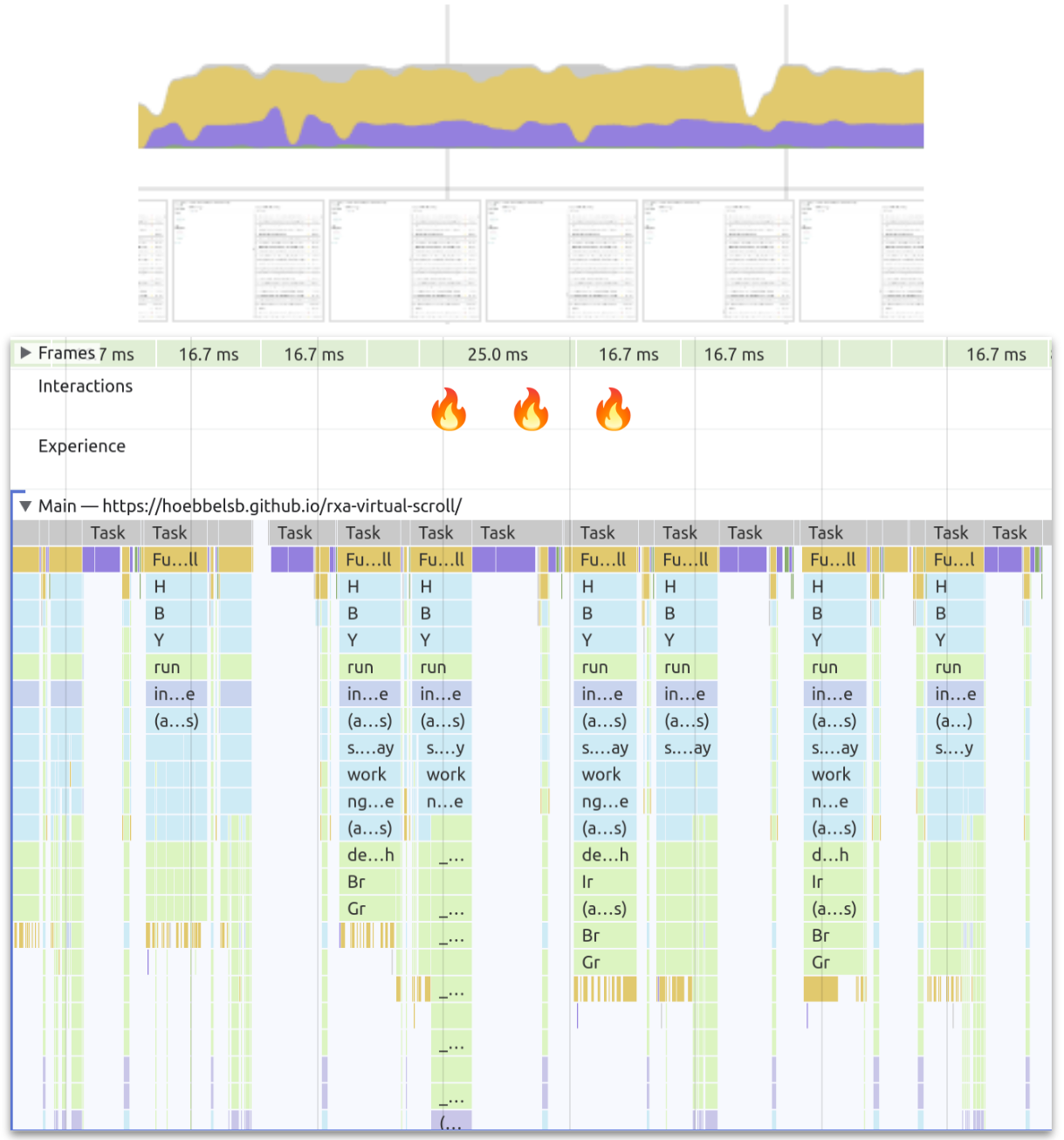 |
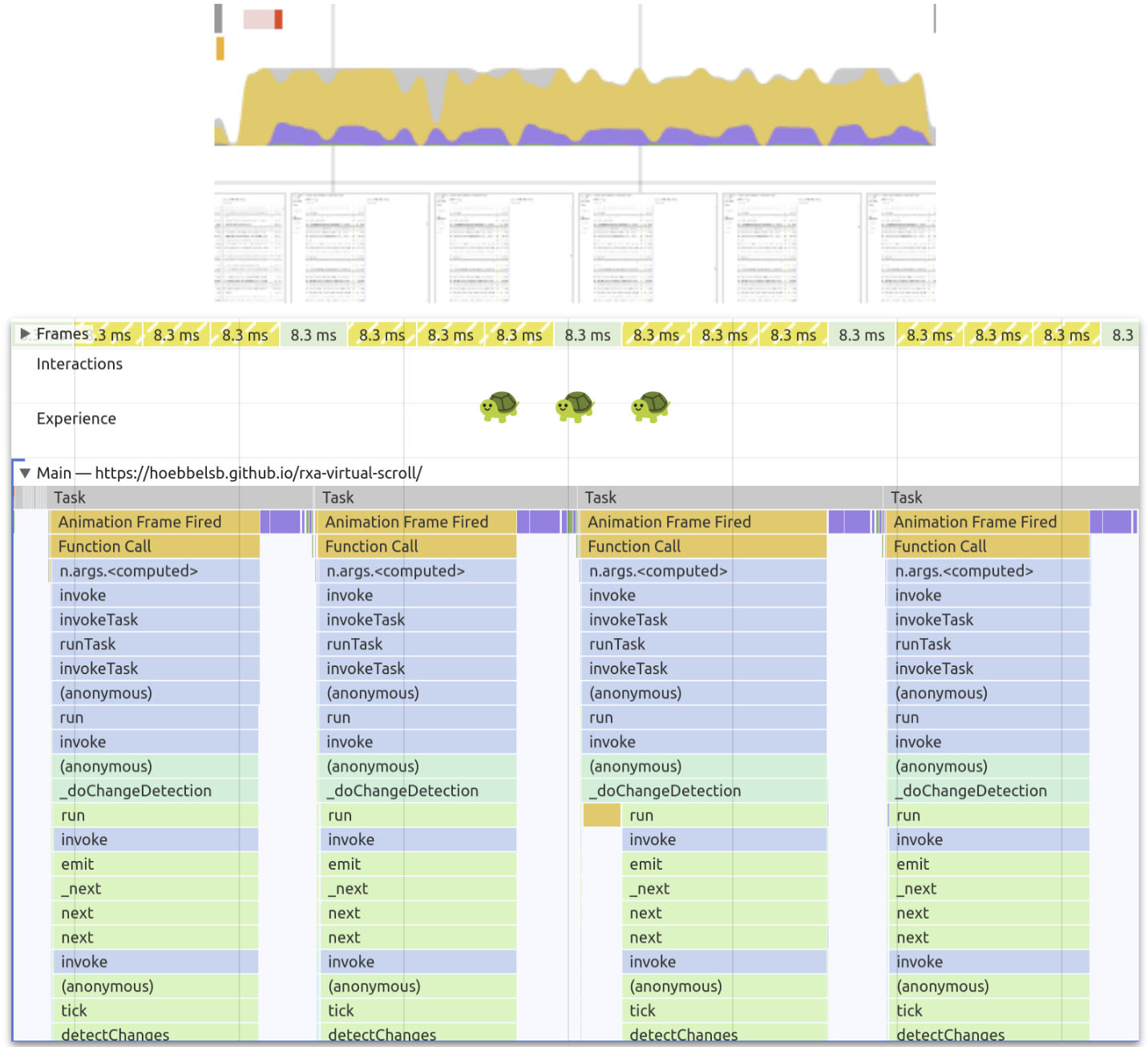 |
4x CPU throttling
With throttling enabled, the CdkFixedSizeVirtualScroll already struggles a lot with keeping the frame rate above anything reasonable. Javascript tasks take up to ~160ms (long-tasks) and
the amount of partially presented frames increases.
The RxAngular FixedSizeVirtualScrollStrategy has no issues whatsoever keeping the frame rate above 30fps on 4x times throttling.
@rx-angular-addons/virtual-scrolling |
@angular/cdk/scrolling |
|---|---|
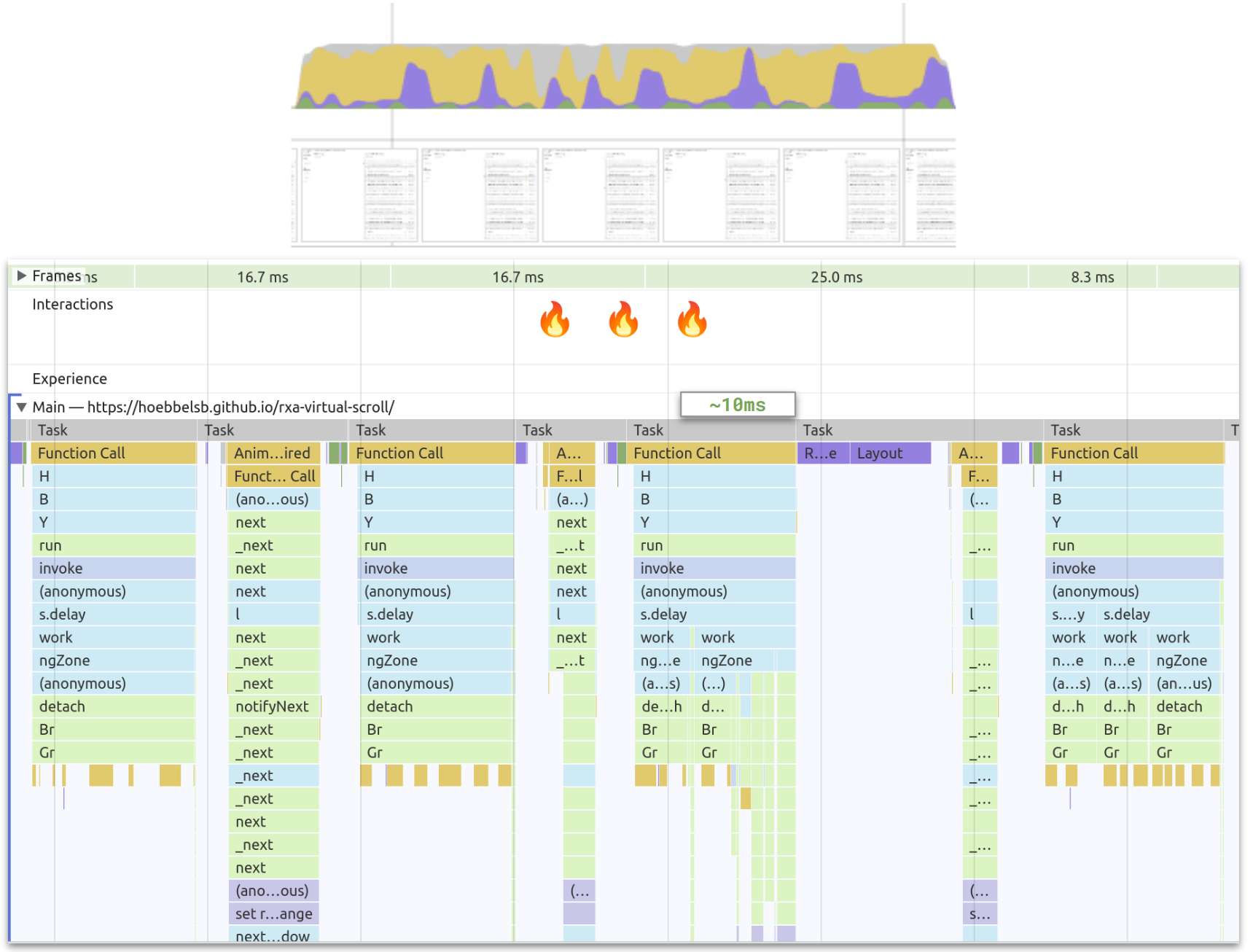 |
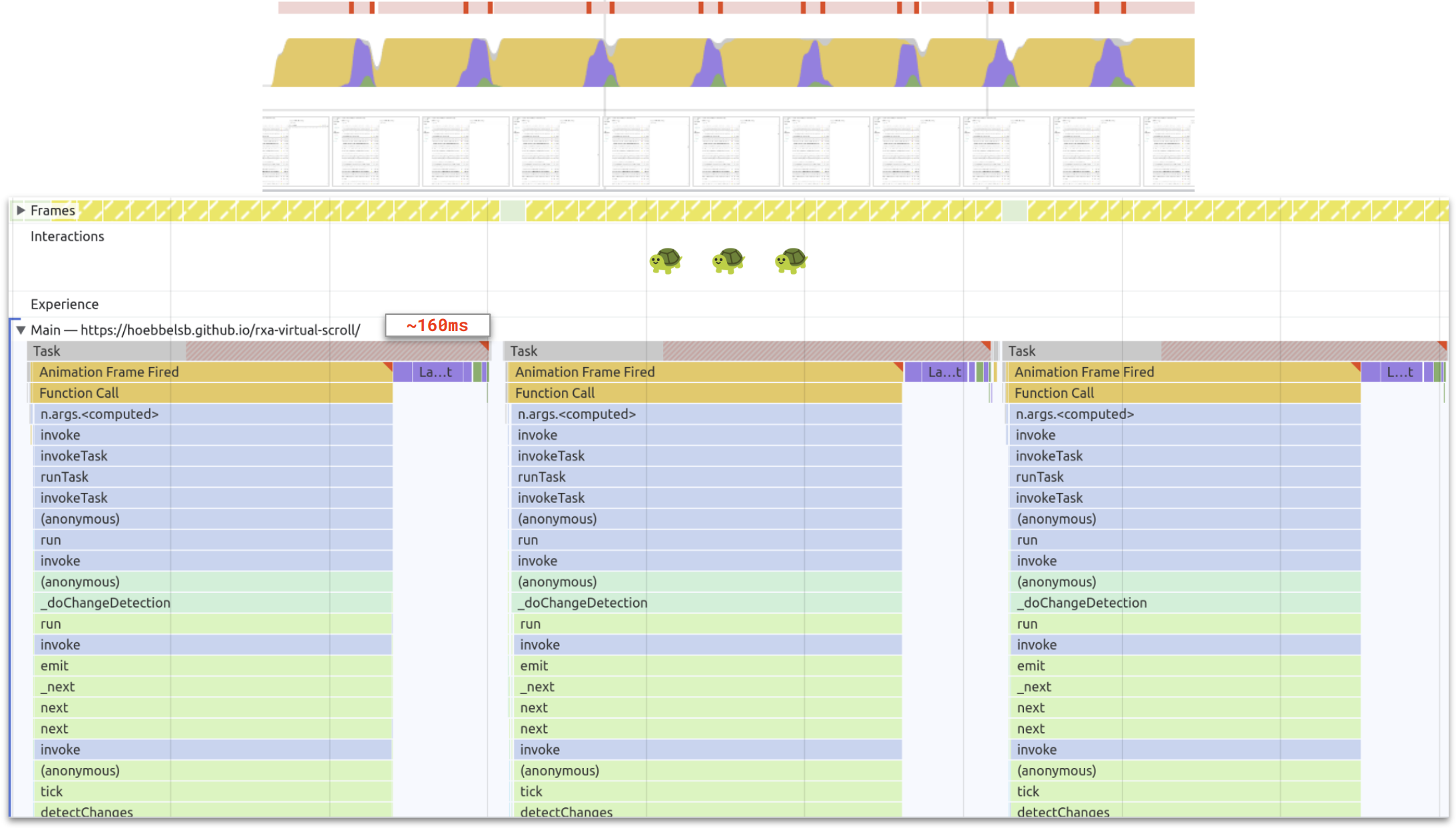 |
Comparison between RxAngular DynamicSizeVirtualScrollStrategy and CDK AutoSizeVirtualScrollStrategy.
As there is no real counterpart to the DynamicSizeVirtualScrollStrategy, the comparison was made against the CDK AutoSizeVirtualScrollStrategy. This is scroll behavior wise the most comparable
implementation from the cdk package.
DynamicSizeVirtualScrollStrategy comparison Demo
As an experimental package, the CDK AutoSizeVirtualScrollStrategy does not emit the current scrollIndex, nor has it a working scrollToIndex method implemented.
The RxAngular DynamicSizeVirtualScrollStrategy is able to do both! It emits the current valid scrolledIndex and is able to properly scroll to the
correct position based on an index.
| Feature | @rx-angular-addons/virtual-scrolling |
@angular/cdk/scrolling |
|---|---|---|
scrolledIndex$ |
✅ | ❌ |
scrollToIndex() |
✅ | ❌ |
No throttling
Both solutions do fine without throttling. But, the CDK AutoSizeVirtualScrollStrategy struggles with the frame rate. We can already spot lots of partially presented frames.
The RxAngular DynamicSizeVirtualScrollStrategy implementation easily maintains a stable framerate around 45fps.
@rx-angular-addons/virtual-scrolling |
@angular/cdk/scrolling |
|---|---|
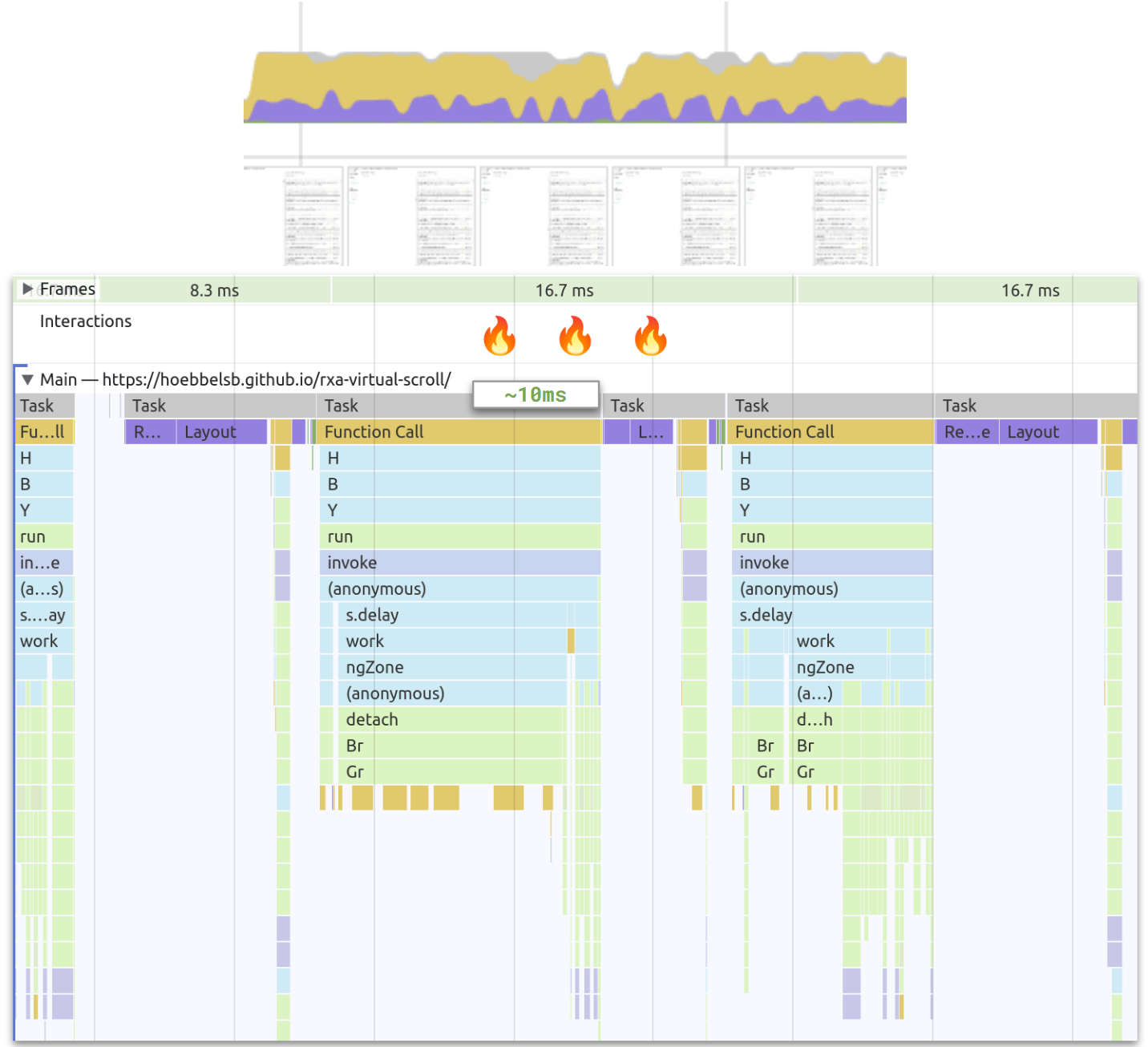 |
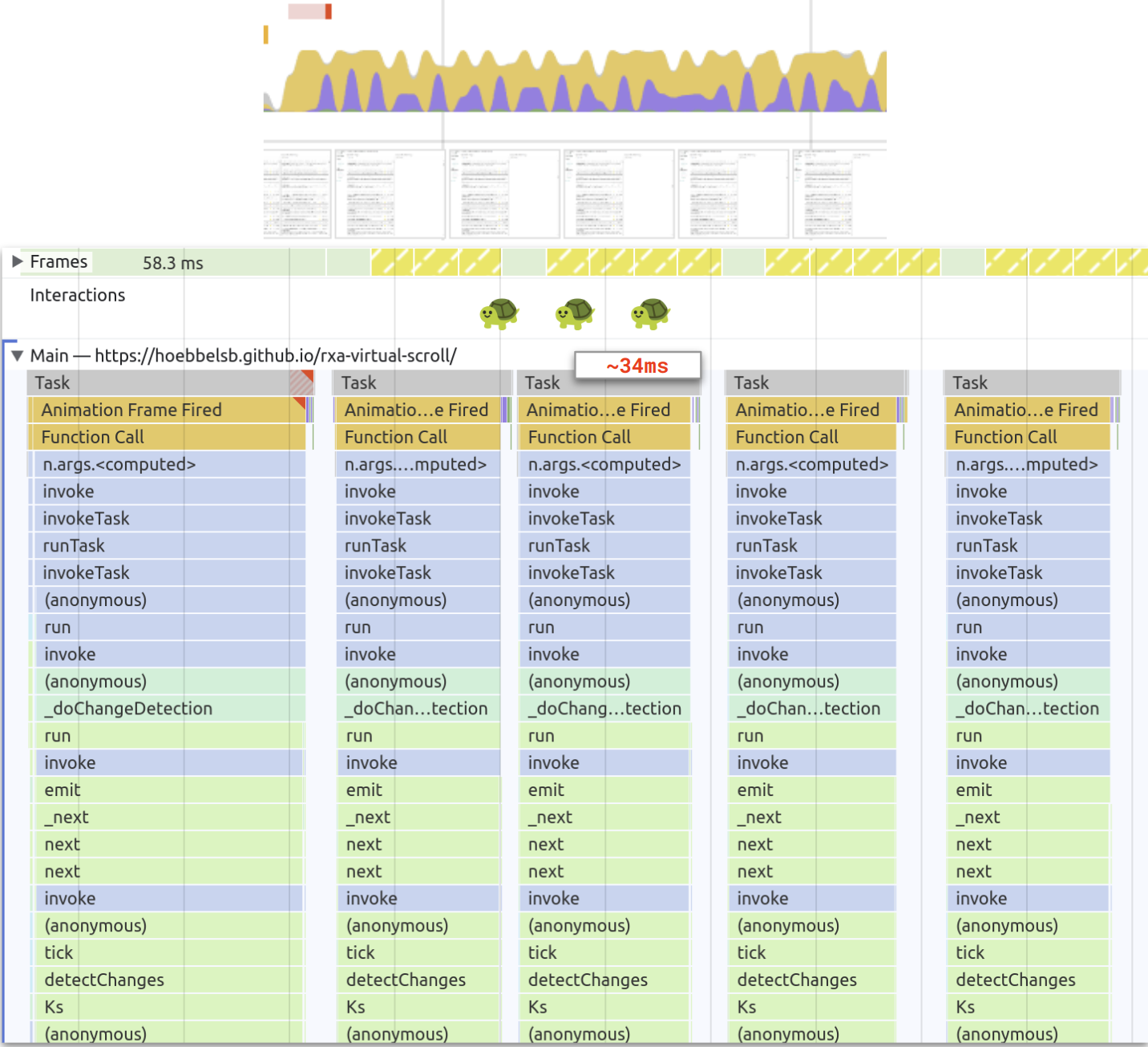 |
4x CPU throttling
With throttling enabled, the CDK AutoSizeVirtualScrollStrategy struggles a lot with keeping the frame rate above anything reasonable. Javascript tasks take up more than ~160ms (long-tasks) and
the amount of partially presented frames increases.
The RxAngular DynamicSizeVirtualScrollStrategy has no issues whatsoever keeping the frame rate above 30fps on 4x times throttling. The javascript execution time is still very low, the style
recalculations and layouting phases are increasing, though. This will also depend very much on the actual use case.
@rx-angular-addons/virtual-scrolling |
@angular/cdk/scrolling |
|---|---|
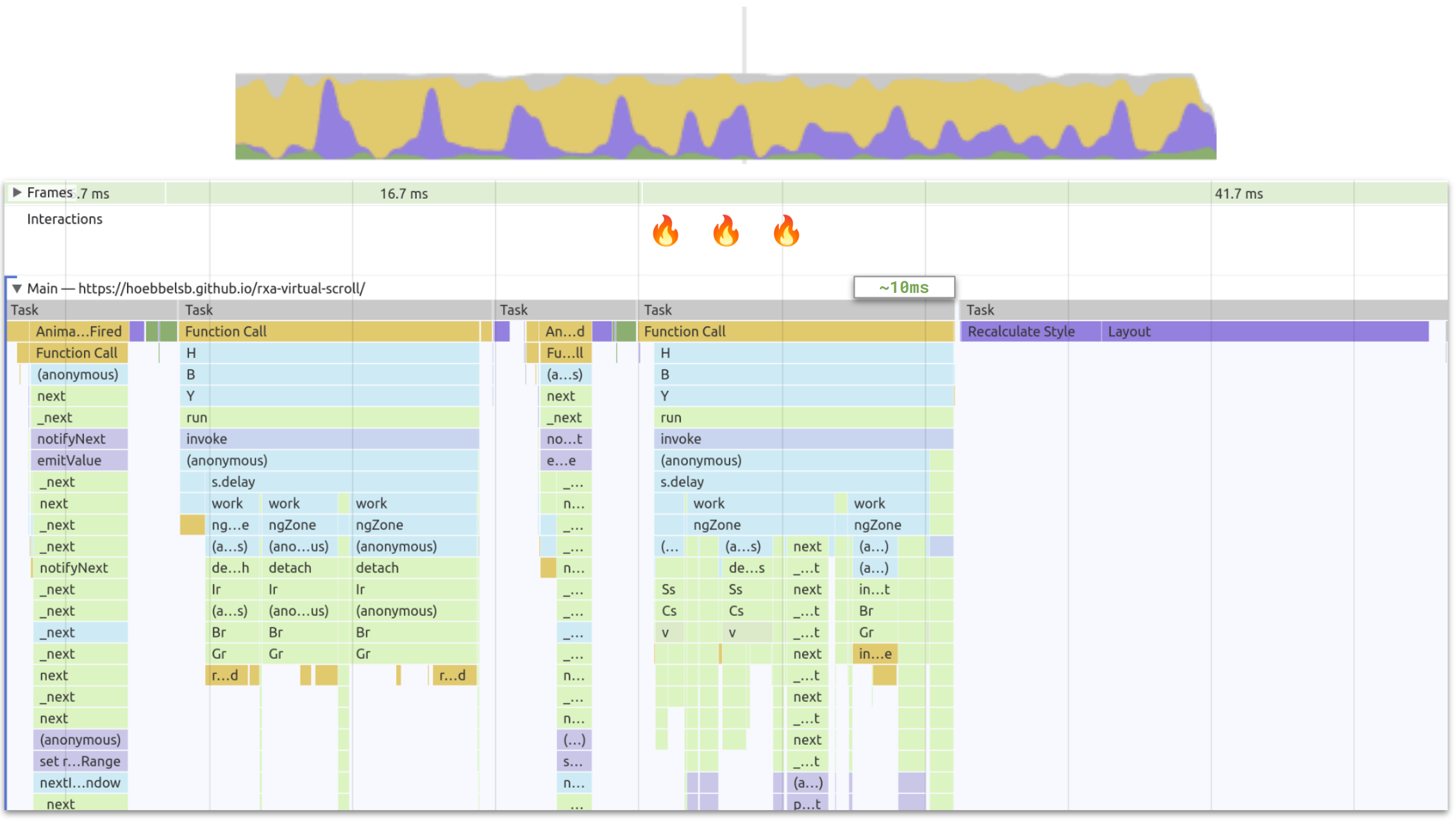 |
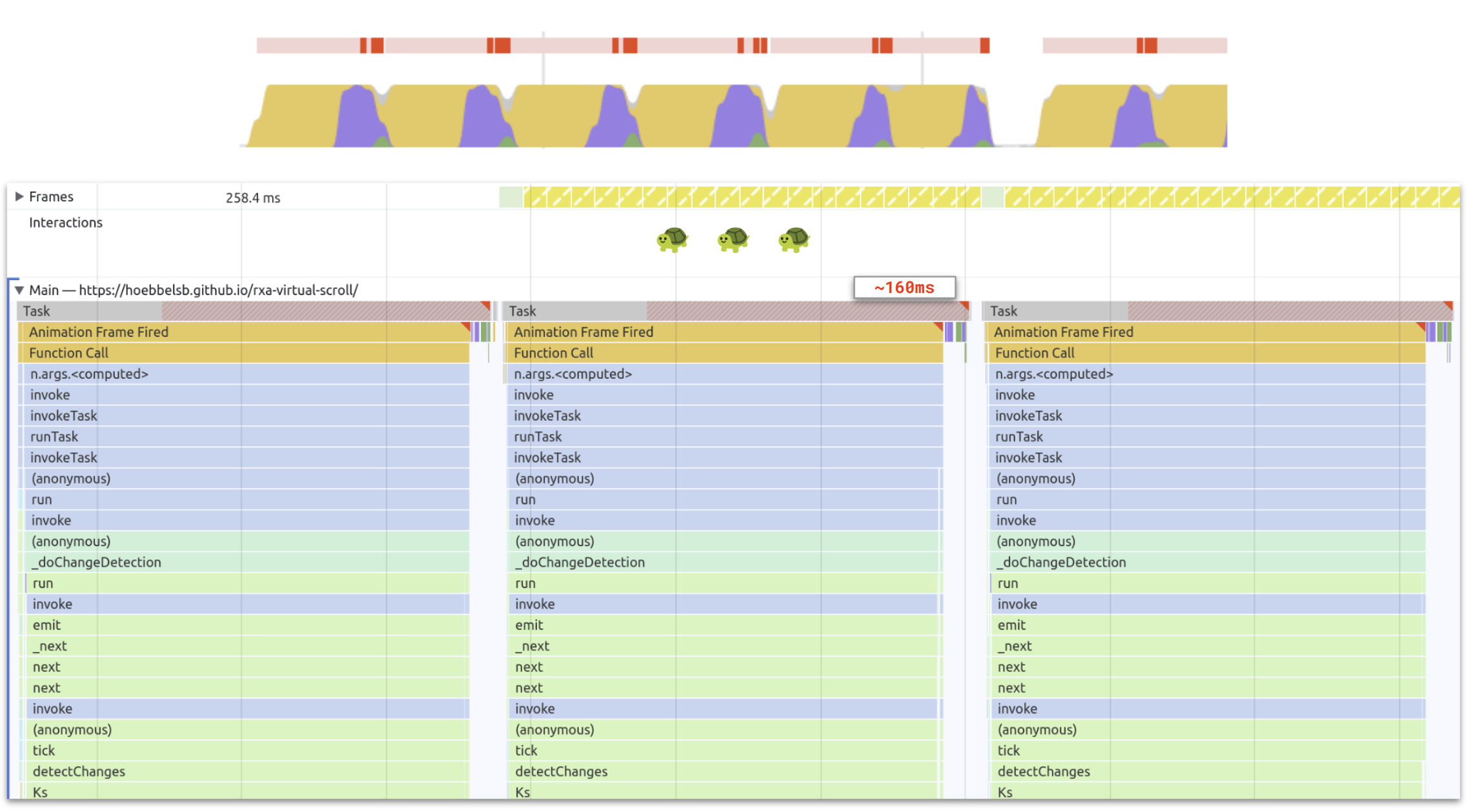 |
Comparison between RxAngular AutosizeVirtualScrollStrategy and CDK AutoSizeVirtualScrollStrategy.
AutosizeVirtualScrollStrategy comparison Demo
As an experimental package, the CDK AutoSizeVirtualScrollStrategy does not emit the current scrollIndex, nor has it a working scrollToIndex method implemented.
The RxAngular AutosizeVirtualScrollStrategy is able to do both! It emits the current valid scrolledIndex and is able to properly scroll to the
correct position based on an index.
| Feature | @rx-angular-addons/virtual-scrolling |
@angular/cdk/scrolling |
|---|---|---|
scrolledIndex$ |
✅ | ❌ |
scrollToIndex() |
✅ | ❌ |
No throttling
For the CDK AutoSizeVirtualScrollStrategy, the same is true as for the comparison vs. the DynamicSizeVirtualScrollStrategy.
The RxAngular AutoSizeVirtualScrollStrategy implementation easily maintains a stable framerate of 60fps. You see the reason why it can maintain this framerate in the
comparison flameshots. The AutoSizeVirtualScrollStrategy puts all the layouting work into the RxAngular scheduler queue which will keep the framebudget for us.
For each inserted view, the AutoSizeVirtualScrollStrategy will cause a forced reflow as it immediately reads its dimensions. It sounds like a disadvantage, but in reality
the scrolling performance benefits from this approach. Anyway, that's why we such heavy rendering peaks (purple color).
Nodes that were visited once are not queried again, scrolling the same path twice will differ in runtime performance. All consequent attempts should be as fast as the fixed or dynamic
size implementations.
@rx-angular-addons/virtual-scrolling |
@angular/cdk/scrolling |
|---|---|
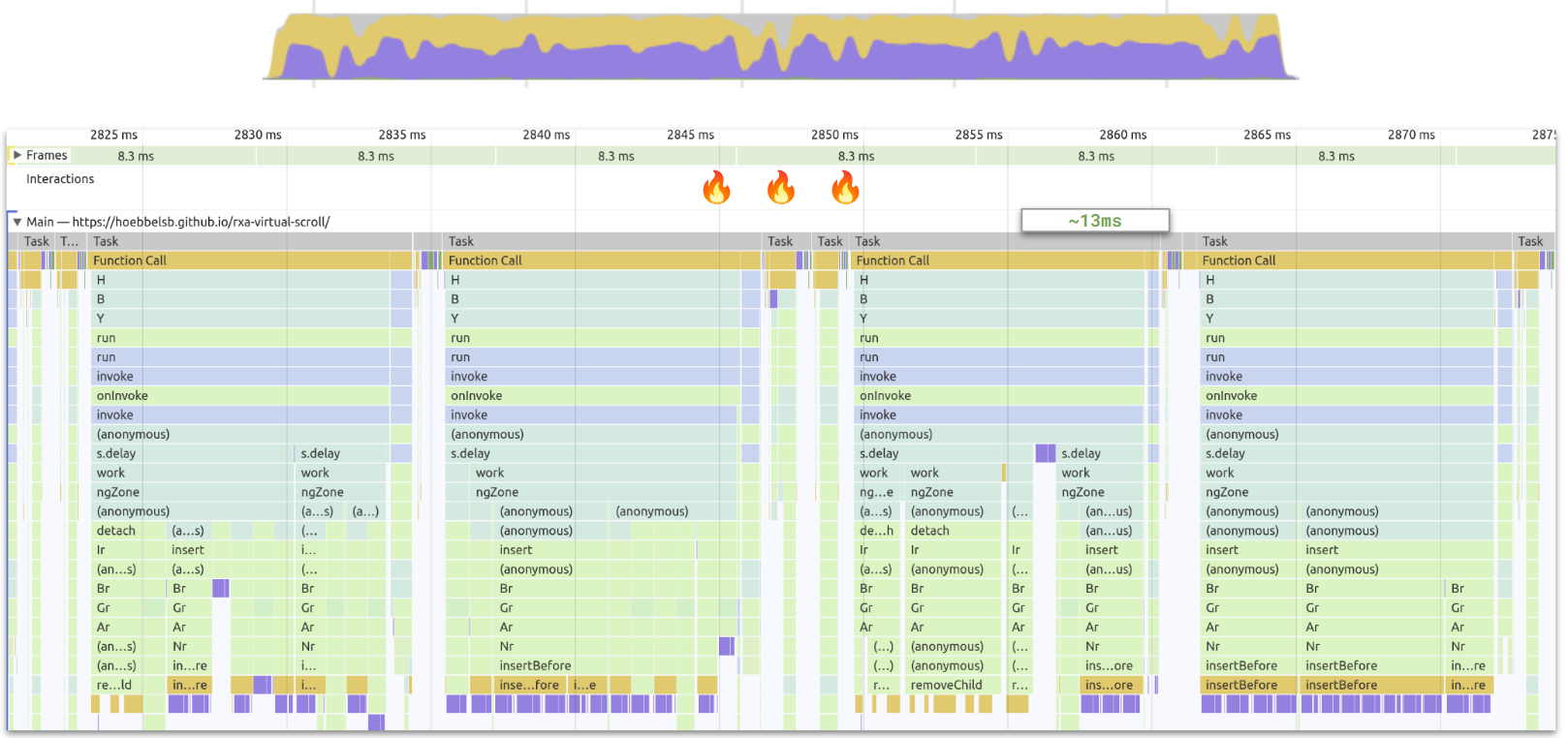 |
 |
4x CPU throttling
For the CDK AutoSizeVirtualScrollStrategy, the same is true as for the comparison vs. the DynamicSizeVirtualScrollStrategy.
Even with 4x CPU throttling enabled, the RxAngular AutoSizeVirtualScrollStrategy keeps a reasonable frame rate and only sometimes produces partially presented frames.
Thanks to the concurrent strategies, users will never encounter long tasks while scrolling.
@rx-angular-addons/virtual-scrolling |
@angular/cdk/scrolling |
|---|---|
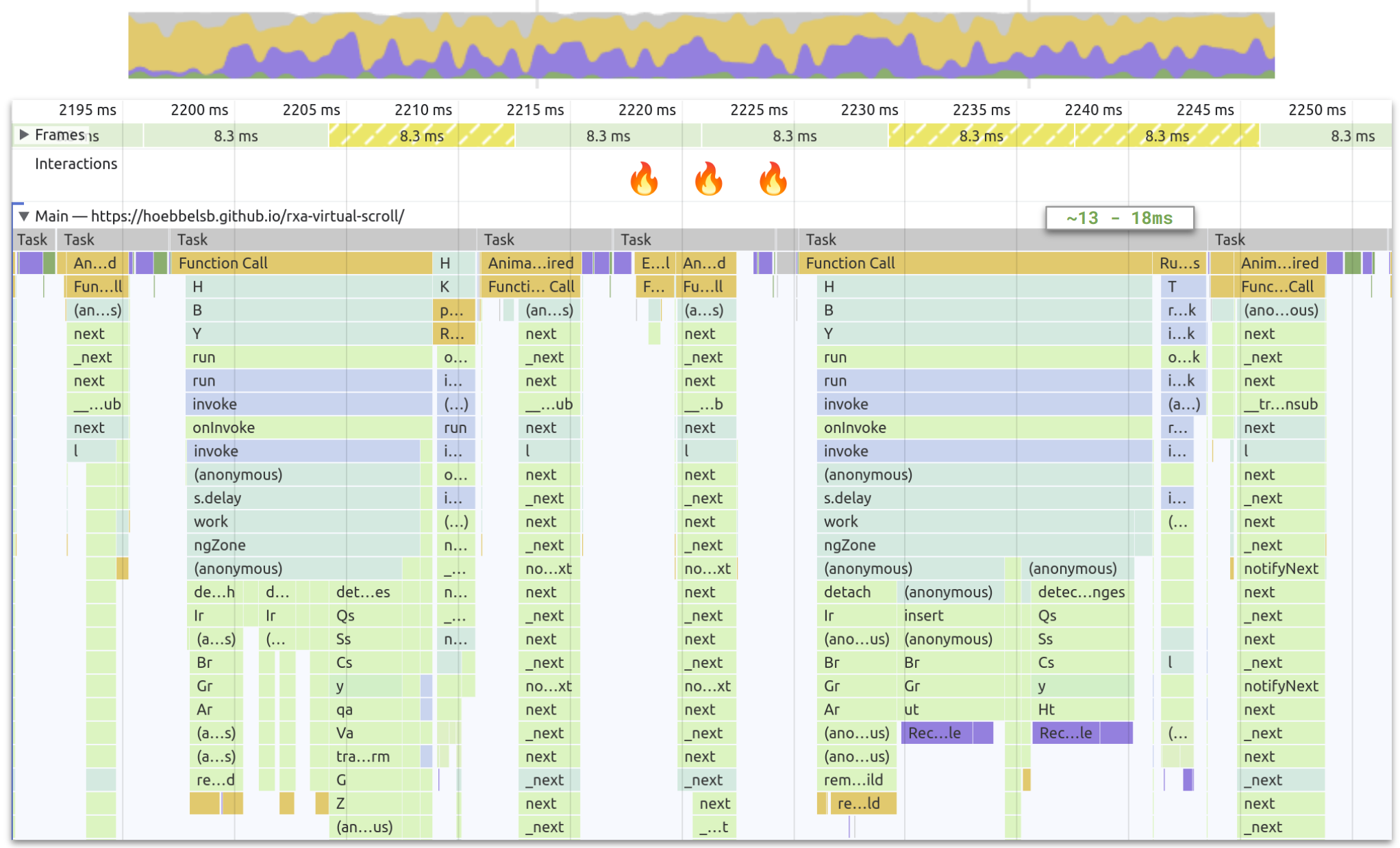 |
 |
